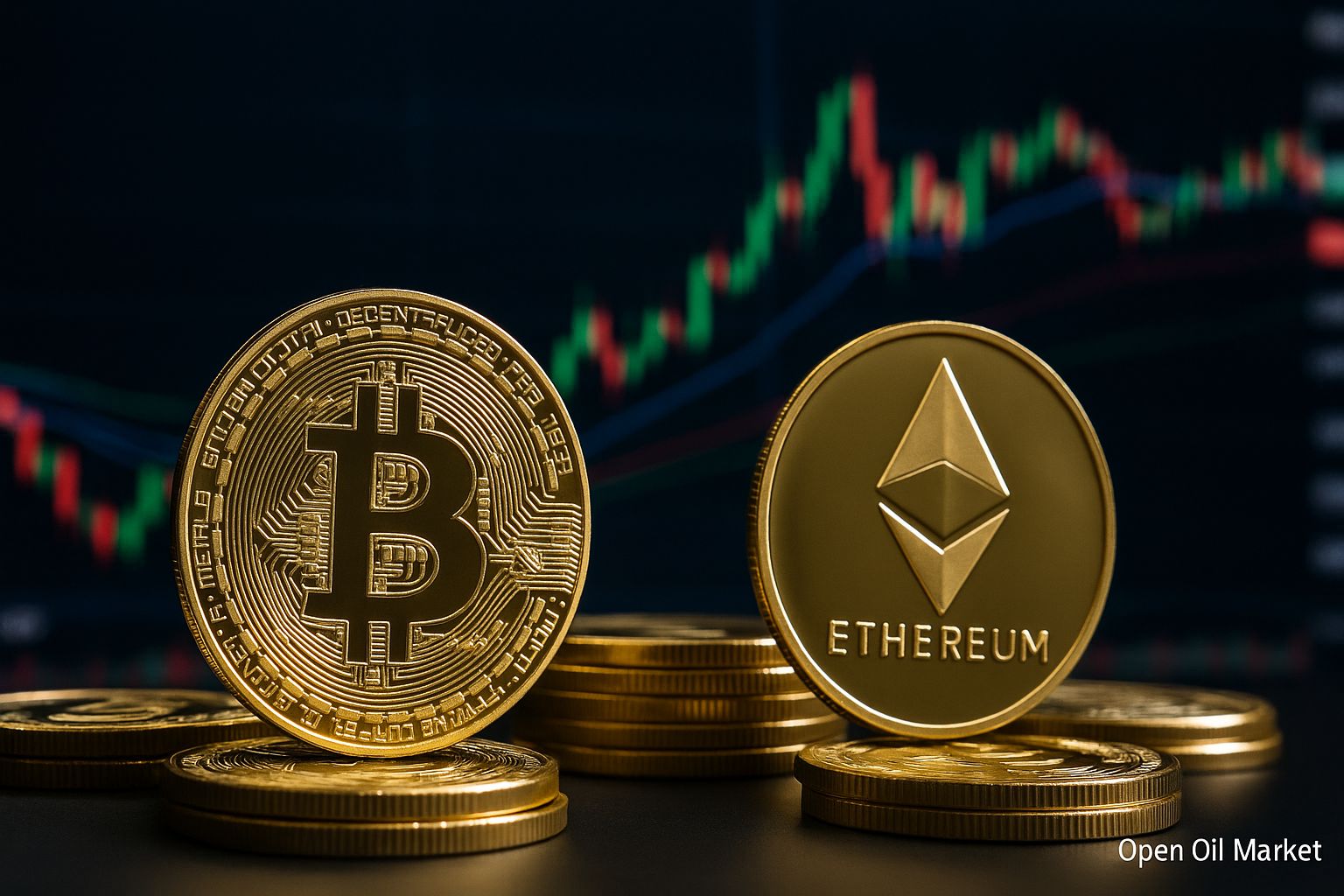
Detailed Overview of Economic Events and Corporate Reports on October 30, 2025. Trump’s Meeting with Xi, Decisions by the Bank of Japan and the ECB on Interest Rates, Release of GDP Data for the U.S. and Eurozone (Q3), as well as Company Reports from the U.S., Europe, Asia, and Russia.
Thursday promises to be eventful for global markets, with several key events in focus. In Asia, investors await the Bank of Japan's decision on interest rates, which could influence the yen's exchange rate, and are monitoring the meeting between Donald Trump and Chinese President Xi Jinping, which may significantly impact the direction of U.S.-China relations. In Europe, the main drivers for the day are the preliminary GDP estimates for Q3 in France, Germany, and the eurozone, released shortly before the ECB meeting. The European regulator is expected to announce its interest rate decision in the afternoon and may provide new signals regarding monetary policy in light of the ongoing battle against inflation and economic slowdown. In the U.S., the publication of the initial GDP estimate for Q3 and new labor market data will serve as a test of economic resilience following a series of Fed interest rate hikes. In addition to macroeconomic data, the busy corporate earnings season continues: today, some of the largest companies from the technology, finance, energy, and consumer sectors in the U.S., Europe, and Asia will report their results. For investors, it is crucial to assess all this information and events collectively to timely adjust strategies and consider possible shifts in market trends.
Macroeconomic Calendar (MSK)
- ?? — USA/China: meeting of Donald Trump with Chinese President Xi Jinping (exact time not announced).
- 06:00 — Japan: Bank of Japan’s interest rate decision.
- 09:30 — Japan: Bank of Japan press conference (Governor Haruhiko Kuroda or his successor comments on the decision).
- 09:30 — France: GDP for Q3 2025 (preliminary estimate).
- 12:00 — Germany: GDP for Q3 2025 (preliminary estimate).
- ?? — Russia: State Duma discusses Main Directions of Unified Monetary Policy for 2026–2028.
- 13:00 — Eurozone: Consumer Confidence Index (October).
- 13:00 — Eurozone: Inflation Expectations of the Population (October).
- 13:00 — Eurozone: GDP for Q3 2025 (preliminary estimate).
- 15:30 — USA: GDP for Q3 2025 (preliminary).
- 15:30 — USA: Initial Claims for Unemployment Insurance (weekly).
- 16:15 — Eurozone: ECB interest rate decision.
- 16:45 — Eurozone: ECB press conference (President Christine Lagarde comments on the decision and forecast).
- 17:30 — USA: Natural Gas Stocks (EIA, weekly).
Bank of Japan: Rate and Yen Dynamics
- The monetary policy of Japan is under close scrutiny: the Bank of Japan may maintain a negative rate or signal a gradual shift away from its ultra-loose stance. Any hints at changing policy (e.g., adjustments to yield curve control) could trigger a surge in the yen's exchange rate.
- Inflation in Japan exceeds the target level of 2%, but the regulator is cautious, weighing risks to economic growth. Investors will analyze the Bank of Japan's rhetoric: a heightened focus on inflation risks could pave the way for future rate hikes.
- Market reactions to the decision: an appreciation of the yen and a rise in Japanese government bond yields are expected if the Bank of Japan adopts a more hawkish tone. This may influence global markets by increasing yields on bonds in other countries and adjusting demand for risk assets, particularly in the financial sector and export-oriented companies.
Europe: GDP and ECB Decision
- Preliminary GDP data for France, Germany, and the eurozone for Q3 will reveal whether the European economy has managed to avoid a downturn. Slowing growth or a technical recession (especially in Germany) could increase pressure on the ECB to soften its policy stance, while surprisingly robust growth would support a hawkish tone from the regulator.
- The European Central Bank will announce its interest rate decision: after a prolonged series of increases leading up to the fall of 2025, the regulator is likely to pause. Investors will focus on Christine Lagarde's comments regarding inflation and economic outlook. Any hints at potential rate cuts in 2026 could weaken the euro and support European stocks, while maintaining a firm rhetoric could increase pressure on the bond market.
- The ECB press conference will also address inflation expectations: fresh consumer confidence data for October and price expectations will be released on the same day. If consumers and businesses expect further easing of inflation, the ECB will have room for more accommodative policies. However, high inflation expectations will prompt the regulator to remain vigilant despite economic headwinds.
USA: Q3 GDP and Labor Market
- The first estimate of U.S. GDP for Q3 2025 will serve as a barometer of the health of the world’s largest economy. Analysts expect moderate growth, but surprises may arise from fluctuations in consumer spending or investments. A higher-than-anticipated GDP growth could lead to an increase in Treasury yields and strengthen expectations for prolonged high rates from the Fed, generally having a negative impact on growth stocks. Conversely, weak GDP data might fuel discussions about easing policy in 2026 but raise concerns about recession.
- The structure of GDP growth will be as important as the headline figure. Investors will closely monitor consumer spending dynamics (the backbone of the U.S. economy), business investments, and trade levels. For example, robust consumer demand supports companies in the retail and service sectors, while declining investments could weigh on the industrial sector.
- Weekly data on unemployment claims will complement the picture of the labor market. With claims at historically low levels, indicating ongoing strength in the labor market, any spikes could signal an early sign of economic cooling. For the Fed, the state of employment is a key benchmark: persistently low unemployment allows for a firm policy stance, but rising claims could bolster arguments for easing in the future.
USA–China: Trump–Xi Meeting
- Geopolitics is back in focus: investors are looking for signals of détente or a new wave of tension from the meeting between former and potentially future U.S. President Donald Trump and Chinese leader Xi Jinping. Topics such as trade relations, tariffs, and technology restrictions are likely to dominate the discussions. Positive statements resulting from the meeting could boost risk appetite in global markets, particularly supporting stocks in the Asian and tech sectors.
- However, there is significant uncertainty: any tough rhetoric from Trump towards China or a lack of concrete agreements might disappoint the markets. Increased protectionist rhetoric from the U.S. could pressure supply chains and impact global companies reliant on production and demand within China (automotive, electronics, luxury sectors).
- The context of the meeting includes the U.S. election season (2024) and the tense U.S.-China relations of recent years. Investors will meticulously read between the lines of official comments, trying to assess whether the tone of dialogue between Washington and Beijing will soften. Even small steps towards rapprochement (e.g., resuming full-scale trade negotiations or agreements on technology exports) could provide momentum for emerging markets and commodities.
Earnings Reports: Before Market Opens (BMO, U.S. and Asia)
- Merck & Co (MRK) — Pharmaceuticals. Focus: sales of key drugs (including oncology and vaccines) and profitability forecast amid changing drug market dynamics.
- Bristol-Myers Squibb (BMY) — Biopharmaceuticals. Key: revenue dynamics from new drugs, strategy for replacing expiring patents, and updated annual forecast.
- Mastercard (MA) — Global Payments. Watching transaction volumes and consumer spending: stable payment growth indicates a healthy economy, while slowdowns could signal household caution.
- Comcast (CMCSA) — Media and Telecom. Attention on new subscriber counts for internet and streaming services, advertising income, and the Peacock platform’s development; investors will assess how the company balances media and telecom businesses.
- S&P Global (SPGI) — Financial Services (indexes, credit rating agency). Important metrics: bond issuance volumes (for ratings operations) and demand for analytical data. A decline in business activity could impact the service sector, while market volatility often increases demand for indexes and data.
- Biogen (BIIB) — Biotechnology. Focus: successes in commercializing new drugs (especially Alzheimer’s therapy), revenue growth in neurology, and sufficient cash flow for developing the next generation of treatments.
- Hitachi Ltd — Industrial Conglomerate (Nikkei 225, Japan). Focus: orders in the infrastructure division and demand for the company’s IT services. Hitachi's results will provide insights into the state of industrial investments and technology in Asia.
- Hyundai Motor Co — Automobile Manufacturer (South Korea). Key: global vehicle sales and operating margin. Special emphasis on growth in the electric vehicle segment and exports; investors will evaluate how costs and currency exchange rates impact Hyundai's profitability.
Earnings Reports: After Market Closes (AMC, U.S.)
- Amazon.com (AMZN) — E-commerce and cloud services. Key metrics: growth in online sales (especially during the holiday sales season) and revenue dynamics from the AWS cloud business. Investors are also looking for signals about the impact of AI implementation costs and logistics expansion on Amazon's margins.
- Cloudflare (NET) — Cloud Infrastructure and Cybersecurity. Focus: growth in corporate segment revenue and progress towards sustainable profitability. Metrics regarding new subscriptions to Cloudflare’s services and retention rates for large clients will show whether demand for web security and content delivery networks remains robust.
- Atlassian (TEAM) — Enterprise Software Developer (Australia). Watching user growth dynamics and success in transitioning clients to cloud versions of Jira, Confluence, and other products. Management comments on macro demand conditions for software—are companies cutting IT spending or continuing to invest in team tools—will also be important.
- Roku (ROKU) — Streaming Platform and Devices. Critical: growth in active user accounts and platform revenue (advertising and content). Investors will assess whether Roku has managed to cut losses through expense optimization and how competition from Smart TVs affects device sales.
- Coinbase (COIN) — Cryptocurrency Exchange. Important to note: trading volumes and commissions revenues amidst market volatility for crypto assets. The report will reveal whether Coinbase has managed to reduce losses independent of Bitcoin prices and whether management comments on the regulatory landscape in the U.S. and prospects for crypto-ETFs will be made.
- Gilead Sciences (GILD) — Pharmaceuticals. Focus: sales of key drugs (for HIV, hepatitis, and oncology) and progress in developing new medications. Investors will evaluate how competition from biosimilars affects revenues and whether Gilead has new growth drivers, such as in cancer immunotherapy.
- DexCom (DXCM) — Medical Devices (glucose monitoring systems for diabetics). Key: expansion of the user base and revenue growth rates, particularly in international markets. Profitability metrics and forecasts for new generations of sensors will determine DexCom’s position in the competitive med-tech market.
- Illumina (ILMN) — Genomics. Focus: demand for sequencers and consumables for genetic research, as well as the situation concerning its subsidiary Grail (early cancer diagnostics). Investors expect Illumina to show margin improvement and clarify its strategy following a protracted dispute with regulators over acquiring Grail.
- First Solar (FSLR) — Solar Energy. Watch for new order volumes for solar panels, plans for expanding production capacity, and the impact of semiconductor/raw material prices on cost structures. First Solar’s results will serve as an indicator of the health of the renewable energy sector amid fluctuations in energy prices.
- Western Digital (WDC) — Data Storage Manufacturing. Focus: signs of recovering demand for hard drives and flash memory, as well as updates on a potential deal to spin off its NAND business (in partnership with Kioxia). Improvement in pricing conditions in the memory market could reduce losses, while delaying structural changes leaves long-term profitability uncertain.
Other Regions and Indices: Euro Stoxx 50, Nikkei 225, MOEX
- Euro Stoxx 50: In Europe on October 30, the peak of the earnings season for major companies is underway. Oil and gas giants Shell and TotalEnergies will report their Q3 results, likely reflecting high trading and extraction profits amid volatile energy prices. The financial sector is also in focus due to reports from Deutsche Bank (banking sector) and AXA (insurance), providing signals regarding the health of the industry in a high interest rate environment. However, the overall tone for the European market is set by macroeconomic indicators (GDP) and the ECB decision—strong surprises here could overshadow the influence of individual corporate news.
- Nikkei 225 / Japan: The financial reporting season for H1 2025 (Q2 of the fiscal year) continues among Japanese companies. Several industrial and technology leaders, including Hitachi (engineering and IT) and Advantest (semiconductor manufacturing equipment), will report results reflecting global demand for capital goods and chips. Astellas Pharma will also provide its figures, offering insights into the pharmaceutical sector. Investors in Tokyo are considering the external backdrop: sharp movements in the yen after the Bank of Japan meeting may impact valuations for exporters and overall market sentiment.
- MOEX / Russia: The Russian market is entering the peak period for publishing financial results for the first nine months of 2025. Key issuers are reporting: Sberbank, for instance, announced a ~6.5% YoY increase in net profit (IFRS) to over 1.3 trillion rubles, while Gazprom has reduced its net loss according to RAS results for nine months. On October 30, results from several other major companies in the energy, metals, and retail sectors are expected. Traditionally, the main wave of releases from blue chips occurs at the end of October—beginning of November. Investors are also focused on signals from the State Duma regarding monetary policy and the overall external environment, as these affect sentiments in the domestic market alongside corporate news.
Day's Summary: What to Pay Attention to as an Investor
- Central Banks and Bonds: The morning decision from the Bank of Japan and the evening ECB meeting set the tone for global markets. Changes in regulators' rhetoric directly impact bond yields and currency exchange rates (yen, euro), which in turn influence the attractiveness of bank sector stocks (sensitive to rates) and exporting companies.
- U.S. and Eurozone GDP: Macroeconomic data (particularly U.S. GDP) could lead to noticeable market fluctuations. Unexpectedly strong growth in the U.S. economy would bolster expectations for continued tight monetary policy from the Fed and may trigger a sell-off in bonds alongside rising yields, which would weigh on stocks, particularly in the technology sector. Conversely, weak data might raise discussions about potential future rate cuts, supporting bonds and potentially favoring growth-oriented segments of stocks.
- USA–China: The outcome of the Trump–Xi meeting is a significant geopolitical risk factor. Any signs of thawing relations (e.g., trade or technology agreements) could enhance investor sentiment, boosting quotes in the Asian region and commodity prices. If the tone remains confrontational, safe-haven assets (yen, gold) may receive support, while stocks reliant on China could come under pressure.
- Corporate Earnings: Carefully monitor key companies. Before the market opens, the reports from Merck, Mastercard, and other giants may set the tone for the healthcare and financial sectors. After the market closes, particular focus on the technology sector: results from Amazon, along with reports from companies such as Cloudflare, Roku, and Gilead, could drive movements in individual stocks and potentially the entire Nasdaq, drawing attention away from macro data.
- Risk Management: The day is filled with events—high volatility is likely in forex, yields, and various assets. Investors should pre-determine acceptable fluctuation ranges for their portfolios and set protective measures (stop-losses, hedging) in case of sharp movements. Divergent impulses from macro data and earnings require heightened attention to correlations between markets (e.g., “U.S. yields ↔ tech stocks” or “China news ↔ commodity currencies”) for timely position rebalancing.




